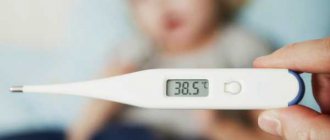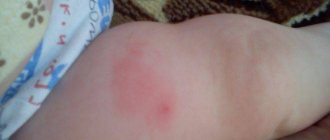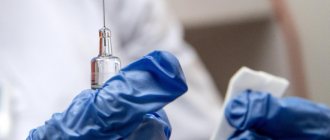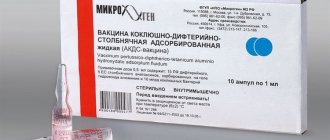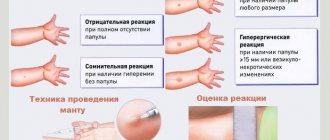DTP is an adsorbed pertussis-diphtheria-tetanus vaccine, which is given to every child from the first months of life. Despite the fact that vaccination reliably protects the baby from deadly diseases, some parents are more frightened by the prospect of encountering an adverse reaction to this drug.
Since the solution contains dead microbes of pathogens, the most common consequence of vaccination may be fever, redness or swelling after DTP vaccination. What to do if such symptoms occur, how long this condition will last, and whether you should worry, we will tell you further.
Possible adverse reactions to DTP vaccination
Since the first vaccination is usually given at three months of age, the injection site is chosen on the outer side of the thigh - there is less fatty tissue here, which means the drug is absorbed faster. That is why parents often turn to the pediatrician with complaints that the leg is swollen after DTP. However, slight swelling is a normal reaction of the child's body to the vaccine.
Subsequent injections are administered according to a special schedule: the first three times with an interval of 1.5-2 months, the fourth time – after a year. For older children and adults, the vaccine is given in the shoulder.
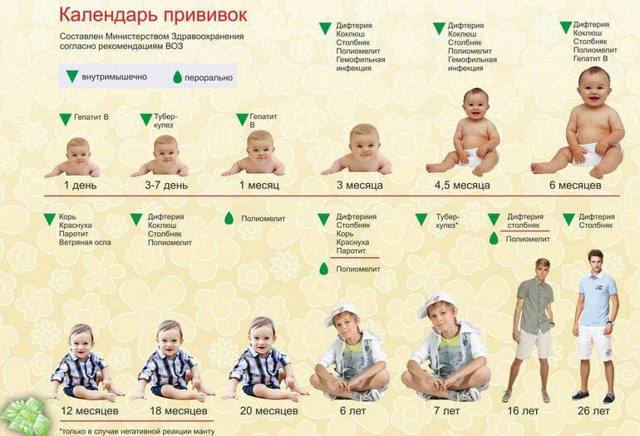
Other undesirable effects may include:
- lack of appetite;
- colic, diarrhea or vomiting;
- fever, weakness;
- cough and runny nose.
Typically, side effects of the injection are observed for 2-3 days. During this period, it is necessary to closely monitor the child’s health: during the day you should not wet or comb the injection site.
And if the temperature rises sharply to 38.5o or higher, you need to urgently consult a doctor! Severe diarrhea and vomiting should also not be ignored - immediately report these complications to your pediatrician.
Child's leg is swollen
If your child's leg is swollen after a DTP vaccination, do not rush to panic. An inflamed area with a diameter of up to 3 cm should not cause concern; on the contrary, such a reaction can be considered a good sign - the vaccine has begun to act, which means the child’s body acquires immunity. If all sanitary standards were observed during the procedure, the swelling will soon subside on its own.
Lump (seal) at the injection site
Sometimes a painful lump appears at the injection site, the formation of which is caused by infiltration. It can accumulate for up to two weeks, and is also considered a natural reaction to the administration of the drug. Small lumps after vaccination (about 8 cm) are normal. An iodine mesh will help reduce the accumulation of cells, blood and lymph, as well as reduce pain.
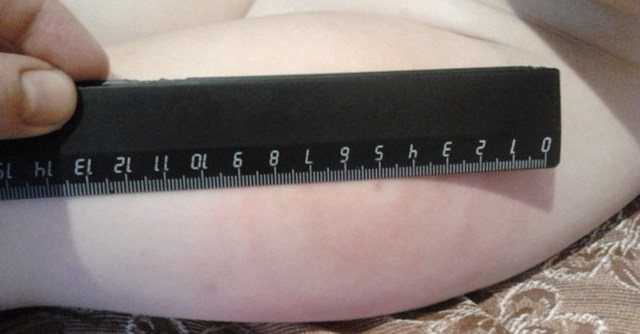
Redness, itching
If the vaccination site turns red, then an allergic reaction to the vaccine is occurring. There is no need to worry; after a few days the redness will subside on its own. To alleviate the condition, you can use anti-inflammatory ointment.
Itching and redness most often appear after the second or third vaccination, while such a reaction is less typical for the first procedure.
After consultation with a pediatrician, the child can be offered antihistamines - Zyrtec, Fenistil.
What to do to eliminate the side effects of the injection
There are a number of methods to combat the unpleasant consequences of vaccination against diphtheria, tetanus and whooping cough. Possible treatment may include folk remedies, medications (ointments, gels, drops, antipyretics), massage.
Drug therapy
When the temperature rises to 38.5o, antipyretics are given. For a small child, Nurofen or Panadol syrups are best suited. Medicines can be given from 3 months, they have a pleasant taste and last a long time. Rectal suppositories with paracetamol also help well.
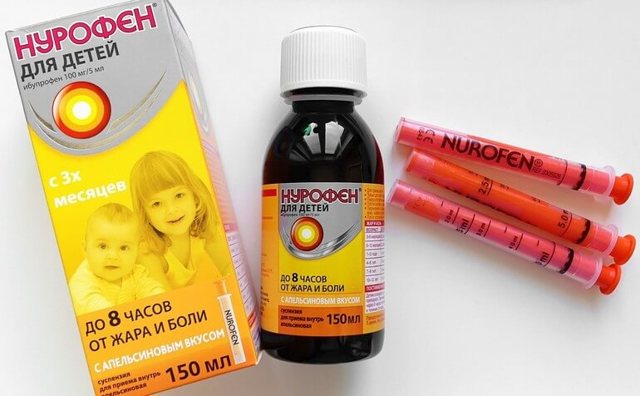
Spasatel and Traumeel ointments effectively deal with lumps and lumps; they are applied before bedtime. Draw an iodine grid on your baby's skin to help relieve pain.
To improve blood circulation, Troxerutin gel is suitable; the drug is applied with light massage movements. Heparin ointment will help remove swelling.
Itching, swelling and redness are effectively relieved by Fenistil drops or gel. The active ingredient of the drug, dimethindene maleate, has antihistamine properties. Zyrtec drops have a similar effect. They are prescribed to children from 2 years of age.
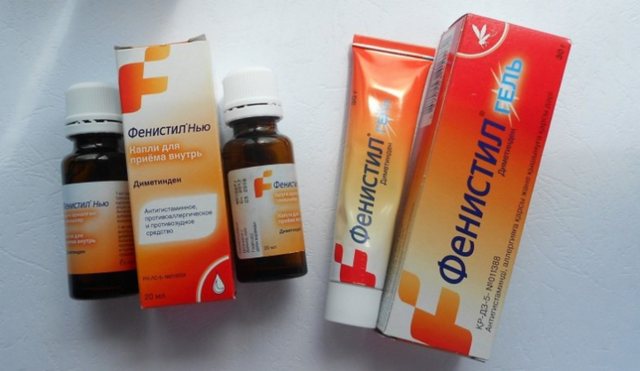
Before using any medicine, be sure to consult your pediatrician. Dosages are selected strictly individually, self-medication is unacceptable!
Traditional methods
In addition to medications, traditional methods will help reduce the unpleasant consequences of vaccination, among which the most popular is a compress after DPT.
Under no circumstances should you use alcohol or alcohol-containing preparations as a compress! Also avoid using cling film and other materials that can create a greenhouse effect and, conversely, worsen the condition.

- Natural materials are best. A cotton cloth is soaked in a soda solution and applied to the inflamed area of the skin. Leave until completely dry. To prepare the solution, 1 tsp. soda is diluted in a glass of warm water.
- For babies, a fresh cabbage leaf is applied to the leg. It reduces the inflammatory process and relieves swelling. The leaf should be warm, so the healing properties will appear faster. If the cabbage has been in the refrigerator for a long time, let it warm up first.
- A honey compress after DPT has proven itself well. Add egg yolk and a few drops of olive oil to slightly warmed honey. The resulting composition is mixed, wrapped in cotton cloth and applied to the sore spot. The top of the compress can be covered with paper.

Massage will help to avoid stagnation; light hand movements begin immediately after the injection. This improves blood circulation, preventing the accumulation of infiltrate.
Who should not get the DPT vaccine?
Despite the obvious benefits of DPT vaccination, there are a number of contraindications to its use.
Doctors do not recommend an injection if:
- the baby was born prematurely and spent some time in an oxygen pressure chamber;
- the child has recently suffered an illness and has not had time to restore immunity;
- the baby is currently suffering from acute respiratory infections;
- any of the parents is intolerant to this vaccine.
Depending on the contraindications, a decision is made to postpone the vaccination date or replace DTP with another drug. Among analogues, the most common are the French Infanrix and the new acellular vaccine Pentaxim.
Pentaxim, in addition to the triad - whooping cough, diphtheria, tetanus - protects against polio and hemophilus influenzae infection. Infanrix, in turn, is easier to tolerate, because practically does not cause side effects. However, remember that this drug requires special storage conditions at a certain temperature, so it makes sense to purchase it immediately before vaccination.
Diphtheria - symptoms and treatment
Diphtheria (from the Latin diftera - film; pre-revolutionary - “disease of crying mothers”, “disease of horror of mothers”) is an acute infectious disease caused by toxigenic strains of the diphtheria bacillus, which toxically affect the circulatory system, nervous tissue and adrenal glands, and also cause fibrinous inflammation in area of the entrance gate (places of infection). Clinically characterized by a syndrome of general infectious intoxication, maxillary lymphadenitis, tonsillitis, local inflammatory processes of a fibrinous nature.
Etiology
Kingdom – Bacteria
genus – Corynebacterium
species – Corynebacterium diphteriae
The causative agent of diphtheria is gram-negative rods located at an angle V or W. At the ends there are club-shaped thickenings (from the Greek coryne - club) due to volutin granules. There is a property of metachromasia - staining not in the color of the dye (according to Neisser - dark blue, and bacterial cells - light brown).
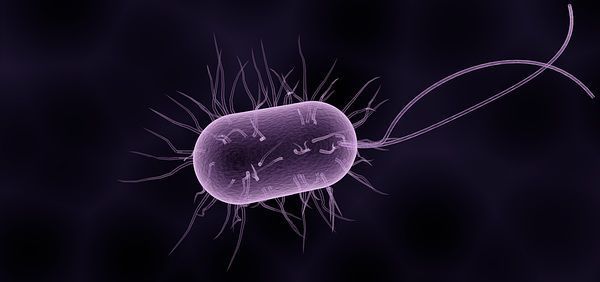
Contains lipopolysaccharide, proteins and lipids. The cell wall contains a cord factor, which is responsible for adhesion (sticking) to cells. Colonies of mitis, intermedius, gravis are known. They remain viable in the external environment: under normal conditions they remain alive in the air for up to 15 days, in milk and water they live up to 20 days, on the surfaces of things - up to 6 months. They lose their properties and die when boiled for 1 minute, in 10% hydrogen peroxide - in 3 minutes. Sensitive to disinfectants and antibiotics (penicillins, aminopenicillins, cephalosporins). They love nutrient media containing sugar (McLeod's chocolate medium).
Identifies pathogenic products such as:
1) Exotoxin (synthesis of the toxin is determined by the tox+ gene, which is sometimes lost), including several components:
- necrotoxin (causes necrosis of the epithelium at the entrance gate, damages blood vessels; this leads to exudation of plasma and the formation of fibrinoid films, since the enzyme thrombokinase is released from the cells, which converts fibrinogen into fibrin);
- true diphtheria toxin is an exotoxin (close in action to cytochrome B, the enzyme of cellular respiration; it replaces cytochrome B in cells and blocks cellular respiration). It has two parts: A (an enzyme that causes a cytotoxic effect) and B (a receptor that facilitates the penetration of A into the cell);
- hyaluronidase (destroys hyaluronic acid, which is part of the connective tissue, which causes an increase in membrane permeability and the spread of the toxin beyond the lesion);
- hemolyzing factor;
2) Neuraminidase;
3) Cystinase (allows you to distinguish diphtheria bacteria from other types of corynebacteria and diphtheroids). [2][6]
Epidemiology
Anthroponosis. The generator of the infection is a person suffering from various forms of diphtheria and a healthy carrier of toxigenic strains of diphtheria microbes. A possible source of infection for people is domestic animals (horses, cows, sheep), in which the pathogen can be localized on the mucous membranes, causing ulcers on the udder, mastitis.
How is diphtheria transmitted?
Transmission mechanisms: airborne droplets (aerosol), contact (through hands, objects), nutritional route (through milk).
How to determine if a patient is contagious
Diphtheria is highly contagious. Without treatment, patients infected with diphtheria can spread it for up to four weeks. When taking antibiotics, this period is reduced to four days [11]. The absence of infection can only be determined through tests.
The most dangerous in terms of the spread of infection are people with diphtheria of the nose, pharynx and larynx.
A person is ill who does not have natural resistance (resistance) to the pathogen and does not have the required level of antitoxic immunity (0.03 - 0.09 IU/ml - conditionally protected, 0.1 and higher IU/ml - protected). After an illness, immunity lasts for about 10 years, then a recurrence of the disease is possible. The incidence of disease is affected by the coverage of the population with preventive vaccinations. Seasonality: autumn-winter. When carrying out a full course of immunization against diphtheria in childhood and regular revaccination (once every 10 years), a strong strong immunity is developed and maintained, protecting against the disease.
How common is diphtheria?
Around the world, about 20 thousand people fall ill with diphtheria every year [9]. Despite the successes of modern healthcare, the mortality rate from diphtheria at the global level (mainly underdeveloped countries) remains within 10%. [1][5]
At-risk groups:
- people who refuse vaccination;
- residents of countries with poor sanitation and high population density;
- travelers coming from regions where diphtheria is common, such as Africa.
Why does swelling appear after DTP vaccination and what to do to get rid of it as quickly as possible?
Parents of the child are very worried when the vaccination site swells after DVT. Therefore, it is necessary to understand whether this reaction is normal, what causes it, how long it lasts, and what needs to be done to prevent more serious complications. You should also take into account useful advice from doctors.
The injection site is red and swollen: normal or a complication?
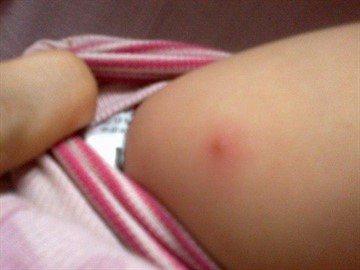
Depending on individual factors, such a reaction may occur immediately after vaccination or after some time. This process is not always pathological. Therefore, there is no need to urgently contact a pediatrician. First of all, it is necessary to determine what is within the normal range and what the complications are.
Redness, swelling and thickening of the skin at the injection site is a common reaction, occurring in about one in four people . As a result of repeated transplantation, this side effect may increase - this is due to the fact that the child’s immunity is ultimately formed.
A tumor at the injection site, up to eight centimeters in diameter, is normal and does not require surgical intervention. Exceeding the diameter by eight centimeters indicates that the doctor’s requirements are not being met, but the swelling is also safe.
After DPT vaccination there is thickening and redness: what to do, do you need to see a doctor?
ACDC is a comprehensive childhood vaccination program to prevent fatal diseases such as whooping cough, tetanus, and diphtheria. Polio vaccination is often carried out simultaneously with DPT.
Vaccination against these diseases is necessary since there is no mass immunity in the population, as is the case with smallpox. Vaccinations are not always easily tolerated by children. Each child's reaction to the vaccine is individual and may be accompanied by redness and swelling at the injection site.
However, if the skin is red and thickened after ACDS, there is no reason to panic.
Is a lump at the DPT vaccination site dangerous?
A red spot after vaccination is a typical reaction of the body to the vaccine. The filling appears 2-3 days after vaccination. The vaccination spot swells and turns red.
The general body temperature may rise to 37°C and the child may feel weak and dizzy. It is common to experience an overreaction with the Pentaxim vaccine. Symptoms disappear after a few days.
This reaction is normal and should not cause concern to parents.
Sometimes complications arise:
- the size of the edema exceeds 1 cm;
- thickening in the form of a tumor is observed;
- body temperature rises significantly;
- the injection site is painful;
- runny nose and cough
If these symptoms do not disappear within 3 days, or the illness lasts longer, the child should be shown to a pediatrician.
- abscess;
- allergic reactions;
- persistent fever;
- diarrhea;
- the child cries constantly;
- lethargy and loss of appetite.
If such symptoms occur, you should consult a doctor immediately. Before vaccination, you must consult with a specialist, listen to his answers and instructions, and strictly follow the recommendations.
The reaction to DPT vaccination can be very severe. This usually occurs when contraindications are not taken into account or when hygiene rules are not followed after surgery. If the following symptoms appear, you should call an ambulance:
WO: How long does it take to respond to ACDS?
- redness in an area greater than 8 cm;
- touching the injection site causes severe pain;
- temperature rise to 39.0-40.0°C;
- severe allergies;
- convulsions.
Causes of redness and thickening at the injection site
Minor redness and swelling caused by DCA is not dangerous and is a typical reaction to the vaccine and will go away on its own. If after vaccination a tumor forms on the thigh or buttocks and does not subside for a long time, this can be considered a local complication.
Reasons for this phenomenon:
- Infiltration. The vaccine accumulates at the injection site and it takes some time for the accumulated material to be absorbed and absorbed.
- Penetration of a needle into adipose tissue. If the vaccination technique is correct, the needle should penetrate the child’s muscles. There are cases when the needle penetrates into the subcutaneous tissue, where the suction force slows down and a tumor forms.
- The reaction of lymphocytes to the penetration of foreign bodies.
- Infection in the wound and inflammation, often with accumulation of pus.
READING: How to learn to inject children in the butt?
Lump with pus
Symptoms that require immediate medical attention:
- Redness is strong, pus accumulates in the infiltration;
- Thinning of the epidermal wall at the injection site, causing spontaneous opening of the epidermis;
- the skin over the seal is very hot;
- the child's leg is swollen;
- a sharp increase in body temperature;
- severe pain, the child is crying.
These symptoms indicate imminent inflammation after vaccination. Only a surgeon can accurately diagnose this disease. An abscess is an inflamed, dense structure that, when softened, releases pus.
The cold form typical of BCG effects is not typical of ACDS. Pus can break out both externally and on the skin and infect muscle tissue. This is dangerous for the child.
In this case, the doctor may prescribe antibiotic therapy or surgery.
Treatment
What to do if the injection site on your leg is swollen?
To make your child feel better, you need to do the following:
- stop taking vitamin D if your child took it before vaccination;
- give the child more to drink, food should be moderate;
- stop walking on the first day after vaccination;
- exclude contact of the injection site with water, do not bathe the child for several days;
- can be applied to the seal using an iodine grid;
- do a gentle massage, without pressing on the seal, moving in a circle;
- cream the problem area with special ointments, which were previously discussed with the doctor;
- Monitor the baby's condition carefully.
WHAT children under one year of age are vaccinated prophylactically?
Ointments for compaction and redness
Medicines should be used after consultation with a pediatrician and determining the cause of the nodular pattern. Your child's condition will improve significantly if you apply medicinal ointment to the surrounding area. The pharmaceutical industry offers many special ointments for removing a nodule after ACDS vaccination:
CAN ALSO BE READ:
- Troxevasin - reduces redness, promotes the absorption of pus, is used when a needle enters adipose tissue;
- Aescusan - improves blood circulation, accelerates vaccine absorption and reduces thickening;
- Fenistil - eliminates itching and pain, the seal on the leg is absorbed;
- Heparin ointment - relieves pain and thickening, Vitaon balm has the same effect.
These medications are available to the public, but they should not be used alone without consulting a specialist. Only a doctor can answer how many drugs can be used once for a child and why this particular drug should be chosen in a particular situation.
Other drugs
In case of complications or if the tumor does not disappear for a long time after vaccination, the doctor may prescribe additional treatment:
- for allergic reactions - antihistamines Fenistil, Zodak, Zirtec;
- for inflammatory processes - antimicrobial drugs;
- for high temperatures - antipyretic Nurofen or paracetamol.
Is it possible to use folk remedies?
Traditional medicine has many ways to help a baby after vaccination. It should be noted that the use of unconventional remedies without consultation with a pediatrician is not recommended, since clumsy manipulations can lead to significant damage to the child’s body, weakened as a result of vaccination.
Parents must know for sure whether the child is allergic to a drug that will be used for therapeutic purposes. For example, if your child is allergic to honey, using honey to dissolve the lump can have serious consequences.
The safest traditional therapies:
- Cabbage leaf compress. In several places, thoroughly wash or cut the cabbage leaves, pour boiling water over them, apply to the affected area and cover with parchment. Leave the compress on for 3 hours. The procedure can be performed during the day while sleeping. This method is considered effective in reducing redness and swelling.
- sodalocia. One tablespoon of drinking water is divided into 100 g of boiled water. Soak a gauze rag in the baking soda solution and apply it to the pad. The lump will shrink. Mix chicken egg yolk
- , a small amount of honey, flour and a tablespoon of butter. Apply the resulting dough to thicken.
- Briolin with aloe juice. It's better to do this in the morning. Aloe compress absorbs unevenness well and has an anti-inflammatory effect.
How do you feel about mandatory vaccination?
- Positively, it prevents many diseases. 60%, 2641 votes
2641 votes 60%2641 votes - 60% of all votes
- Negatively, these are all government schemes to make it easier to manage us. 26%, 1157 votes
1157 votes 26%
1157 votes - 26% of all votes
- Neutral, I don’t think it has any effect on my health. 13%, 592 votes
592 votes 13%
592 votes - 13% of all votes
Total votes: 4390
Votes: 4365
January 17, 2018
×
You or from your IP have already voted.
When to see a doctor for complications
Not all complications are considered a reason to visit a doctor. Most of them (chills, weakness, mild discomfort) go away on their own, but a number of complications and side effects require medical intervention. If it hurts under the shoulder blade, even for a long time, you should not worry when the body’s reaction is not accompanied by Quincke’s edema and other consequences.
Edema and swelling resolve within a few days or months and, as a rule, do not cause serious discomfort. This symptom does not usually require a visit to the doctor. The lump is reduced with compresses, and the pain is relieved with tablets. If it does not resolve within the allotted period, then you need to see a doctor.
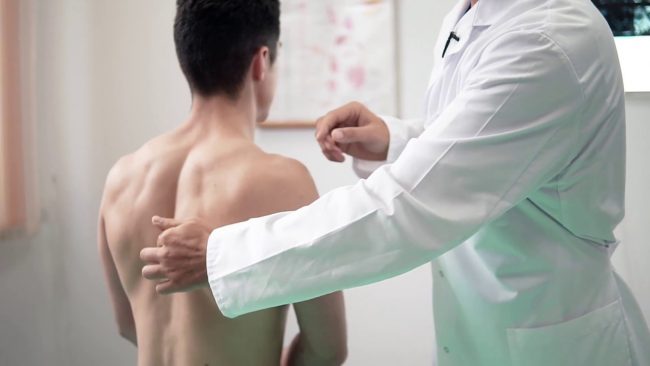
Be sure to consult a doctor if you have vomiting or allergies. The same should be done in case of convulsions, clouding of consciousness or loss of consciousness, if the patient is choking or has severe diarrhea or circulatory problems. These symptoms are a serious cause for concern and require medical attention.
If after vaccination a child has a poor appetite, a headache, a slight fever or is naughty, then this is considered normal. Urgently call an ambulance if you have a severe runny nose, seizures, skin rashes, or unstable heartbeat. A doctor is visited for vomiting and diarrhea, because the child quickly becomes dehydrated. Such complications are quite rare.
It is believed that the injection site is prohibited from getting wet. This is wrong. Water treatments are allowed in most cases. It is not recommended to drink alcoholic beverages, go to a bathhouse or sauna, or rub the puncture site. You should not apply cosmetics or vigorous exercise to this area. Precautions after vaccination are observed for five to seven days.
After DTP vaccination there is thickening and redness: what to do with a bump on a child’s leg?
DPT is a vaccine against whooping cough, diphtheria and tetanus that is given to all children according to the immunization schedule.
Why are parents often afraid of this vaccine and its consequences? This causes unwanted effects in many children: fever, redness, swelling of the legs and buttocks.
And how many days after vaccination a child can have unwanted symptoms, how dangerous they are, is often not known to young mothers.
INTERNATIONAL: How do children of all ages cope with DTP vaccination?
Doctors advise not to neglect the prevention of these diseases, since their consequences are more severe than the side effects of the vaccine. If you have properly prepared for the procedure, you can avoid many inconveniences.
After the ADHD vaccine, the child may also have a bunion on his leg: Is it possible for the child to be vaccinated against ADHD?
Normal body reaction to DTP vaccination
Various medications are used to immunize children: DPT, Pentaxim, Infanrix IPV, Hexa Infanrix, Tetracoccus and Bubo-Cock.
Pentaxim protects against Haemophilus influenzae and polio in addition to whooping cough, diphtheria and tetanus, Hex Infanrix protects against polio and hepatitis B.
The injection is given on a specific part of the body: infants receive the vaccine on the outer thigh, older children and adults receive the vaccine on the upper arm.
READING: Pentaxim vaccine scheme
A reaction to a vaccine often occurs in an infant. Side effects that occur after vaccination and are not health threatening crumbs.
- temperature increase;
- runny nose, cough;
- loss of appetite;
- weakness, lethargy;
- diarrhea, vomiting, colic;
- redness or swelling at the injection site.
Loss of appetite, runny nose, weakness, drowsiness, mild swelling; Redness is a symptom that is common after ACD but is not dangerous.
What should I do if my temperature rises after ACD?
The leg prick usually hurts for two to three days. Even after the injection, an allergic reaction to the skin sometimes occurs.
The allergy occurs after the second or third injection.
If the injection site is red, the child is given an antihistamine such as Fenistil or Zirtek for relief (we recommend reading: How to administer Fenistil before the ACD vaccine).
WO: How do I administer Fenistil to my child?
Prophylaxis helps to avoid unwanted effects after AKD vaccination, such as lump formation.
Prepare your child for vaccination (start taking antihistamines three days before vaccination) and make sure that the procedure is hygienically correct.
The child's health will be closely monitored for several days after vaccination. It is not recommended to urinate or rub the injection site on the first day.
WARNING: Can I bathe my child immediately after receiving the AKD vaccine?
Swelling of an area of the thigh or swelling of the entire leg
It may happen that the thigh area where the medicine was injected or the child's entire pedicure becomes swollen after the ACD or Pentaxima vaccination. This is the body's immune response, which means the vaccine has started working. How long the swelling does not disappear depends not only on the child’s immunity, but also on how well the procedure was carried out.
Infiltrate (bump, lump) at the injection site
Sometimes the swelling that occurs after ACDS does not go away within two weeks. If the lump is not very large (no more than 8 cm), it does not pose a danger, but is a natural reaction of the body. To relieve leg pain and reduce thickening, doctors recommend using simple remedies such as making an iodine mesh at the site of infiltration.
Redness and itching
In the area where the AKDS vaccine was administered, there is slight redness (a red spot with a diameter of 2-4 centimeters) and itching caused by mild local inflammation as a result of the procedure. Again, this is nothing to worry about and the redness around the injection will subside within a few days. If the skin is very red, apply a special anti-inflammatory ointment.
WO: When is the 4th ACDC vaccination given and how is it tolerated? Negative reaction to vaccination
Abscess as a complication after vaccination and methods of its treatment
If after vaccination a child develops a tumor with pus on the thigh, a cold abscess develops - a purulent inflammation of the tissue. This usually happens when hygiene standards are not followed.
There is an infection at the injection site that causes inflammation. An infiltration filled with pus appears under the child’s skin. The lump on the leg does not disappear on its own.
It needs to be opened and washed, the operation is performed by a surgeon.
A post-vaccination abscess is dangerous as it can burst at any time. In this case, its contents enter closed cavities, which leads to a purulent process in them. After surgical manipulation, the patient is prescribed antibiotic therapy.
Helping a child with a pronounced reaction of the body to DTP
To reduce unpleasant symptoms that occur after vaccination, you can use these options to help your child:
- for massage;
- for installing a compress at the injection site;
- to lubricate the leg, where it swells, with a special ointment.
Ointments and gels to eliminate bumps and redness
If after vaccination the child’s temperature rises above 38.5°C, the redness has increased, and the stem is very swollen, you can apply Troxevasin gel or a compress with novocaine to the affected area. This will relieve redness and relieve pain. You can also give your child the antipyretic drug Nurofen or paracetamol syrup. We could administer a paracetamol rectal suppository.
If the filling that appeared after ACDS does not disappear, then
- for allergic itching, swelling and redness, it will help to reduce Fenistyl in drops, for children over 1 year old - 5 drops of Zirtek 1-2 times a day, and for children over 2 years old - Claritin syrup per teaspoon once a day;
- Eskusan ointment and troxerutin gel improve blood circulation and accelerate wound healing;
- Rescue ointment reduces inflammation and absorbs nodules;
- Heparin ointment improves tissue microcirculation and relieves swelling.
Other ways to combat post-vaccination reactions at home
Cabbage leaf
Often parents resort to folk remedies if their child penetrates the injection site:
- curd compression. The product should be heated in a water bath, wrapped in a soft cotton cloth and applied to the seal until the curd has cooled.
- Honey compress. Heat the honey, add the egg yolk and a little olive oil. Mix everything, form a cake, wrap it in cotton cloth and apply it to a lump, cover the top with parchment.
- cabbage leaf Attach to infiltration before bed.
- Compress made of honey and flour. Mix heated honey and rye flour in equal parts. Mix the cake and apply sealant before bed.
- Soda compress. Place one teaspoon of baking soda in a glass of warm water, soak a handkerchief in the baking soda solution and tie the swelling until the bandage dries.
Do not use foil or plastic bags when applying the compress. They create a greenhouse effect rather than exacerbating inflammation.
Pain under the shoulder blade after a vaccine injection: injection area
Why is the vaccine injection given in this particular area? Here, the injected fluid is quickly absorbed and the risk of complications is much lower than in other areas of the body. Typically, the vaccine in the area of the shoulder blade stagnates less and swelling and compaction are less likely to form. Doctors prefer this form of procedure for children over the age of one year and adult patients. Children have a thin layer of fat in this area, which does not allow for an injection according to all the rules.
Typically, injections are given at this site against tetanus, tick-borne encephalitis, diphtheria, rubella and other serious diseases. Flu and mumps vaccinations are often given under the shoulder blade. When a puncture occurs, a person experiences pain and discomfort. The most unpleasant sensations develop after injections against tetanus and diphtheria.
Normal reaction to vaccination
After the injection, the body gives a normal immune response. After receiving the flu vaccine, pain is rare. Most often, pain syndrome occurs after vaccination against diphtheria or tetanus. This is a normal reaction of the body to the introduction of foreign strains of bacteria. Pain may occur for two to three days, and the puncture site may turn slightly red.
Some patients experience a slight rise in temperature, migraines and weakness. Each person's body is individual and can react in its own way. Some patients experience discomfort when moving, others have swelling, and others have migraines. These phenomena resolve on their own without additional treatment. Unpleasant symptoms stop after two to three days.
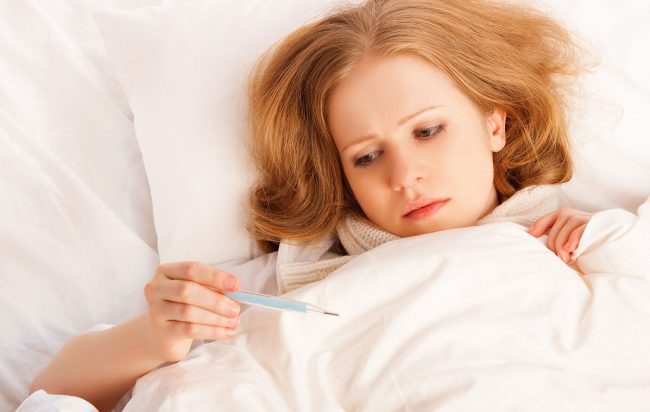
Negative reactions to the injection
The medicine used for vaccination is quite easily tolerated by patients. If the procedure was carried out correctly and the injection was painless, there is no response to the vaccine, then doctors believe that the reaction is normal. In some cases, negative reactions to the administered composition occur. In this situation, local reactions pass quickly.
One of the symptoms of a negative reaction is pain under the shoulder blade. A lump forms at the puncture site, which hurts. This is an immune response of the body that does not threaten life and health. When a person lies on his back or sleeps in this position, he may feel pain when his body comes into contact with a surface. Puffiness and swelling usually disappear on their own within three to five days.
If the tumor is too large, you should consult a doctor for advice. He will advise you on what medications to take and how to alleviate this condition so that the tissue recovers faster after the injection. If the pain under the shoulder blade becomes unbearable, then you can apply compresses with magnesium powder. Troxevasin ointment will help resolve the bumps. Its composition increases blood circulation and eliminates pain.
When the patient's temperature rises after the injection, the puncture site often swells. This is one of the body's reactions to the introduction of strains. Unpleasant symptoms can be relieved with antipyretic drugs. If the temperature does not go down, this means that some kind of infection has been added to the discomfort, for example, ARVI. This has little to do with the strains introduced into the body.
One of the consequences of vaccination may be weakness. A person in this state eats little or does not want to eat at all. If a child is vaccinated, parents should remember that vaccination is stressful. To make you feel better, you can simply take an additional bath with warm water. Water procedures after vaccination are not prohibited.

During the post-vaccination period, you may experience a headache. This happens less often. It's best to sleep. If your head aches, you can apply a cotton rag or towel moistened with water to it. If the pain does not go away and greatly torments the patient, it is recommended to take a painkiller tablet.
Another negative reaction is nausea, possibly an upset stomach. This condition is rare, but depends on the characteristics of the body. If a person includes a new product in his diet and gets vaccinated at this time, then the body’s reaction becomes less predictable and can lead to bowel disorders.
Popular Protecting the body from chickenpox by injection vaccination
The patient may even develop vomiting. If you have such symptoms, you need to see a doctor. The loss of water in the body should not be ignored. The patient should drink more fluids. Loss of appetite may last up to three days. During this period, the body develops immune protection against the strains contained in the vaccine. Then the condition will normalize and your appetite will appear.



